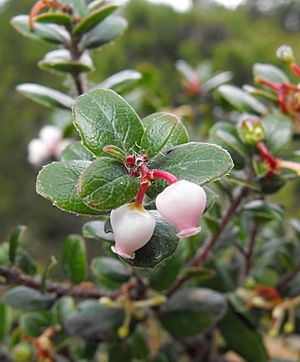Pygmy manzanita facts for kids
Quick facts for kids Arctostaphylos nummularia subsp. mendocinoensis |
|
|---|---|
 |
|
| Scientific classification |
|
| Kingdom: | Plantae |
| Clade: | Tracheophytes |
| Clade: | Angiosperms |
| Clade: | Eudicots |
| Clade: | Asterids |
| Order: | Ericales |
| Family: | Ericaceae |
| Genus: | Arctostaphylos |
| Species: | |
| Subspecies: |
A. n. subsp. mendocinoensis
|
| Trinomial name | |
| Arctostaphylos nummularia subsp. mendocinoensis (P.V.Wells) V.T.Parker, M.C.Vasey & J.E.Keeley
|
|
| Synonyms | |
|
|
The pygmy manzanita (scientific name: Arctostaphylos nummularia subsp. mendocinoensis) is a special type of manzanita plant. It's called "pygmy" because it's quite small! This plant is found only in one specific place: Mendocino County, California. You can find it growing in small, spread-out groups in the unique pygmy forests close to the coast. Being "endemic" means it naturally lives nowhere else in the world.
About Pygmy Manzanita
This plant is a small shrub that grows close to the ground, forming low, rounded shapes. It usually stays less than half a meter (about 1.5 feet) tall. The pygmy manzanita has reddish bark that often peels off in thin strips, which is called "shreddy bark." Its smaller branches have tiny, stiff hairs, like bristles.
Leaves and Flowers
The leaves of the pygmy manzanita are dark green and look shiny. They are curved outwards (convex) and feel smooth because they don't have any hairs. These leaves are quite tiny, usually less than one centimeter (about 0.4 inches) long.
When the plant blooms, its inflorescence (which is a fancy word for a cluster of flowers) is very dense. The flowers are shaped like small urns or jars, and they have four tiny rounded parts at their opening.
Fruit
After the flowers, the plant produces a small fruit called a drupe. This fruit is shaped like a cylinder and is only a few millimeters long. Inside each fruit, there are four very tiny seeds.
See also
 In Spanish: Arctostaphylos mendocinoensis para niños
In Spanish: Arctostaphylos mendocinoensis para niños

